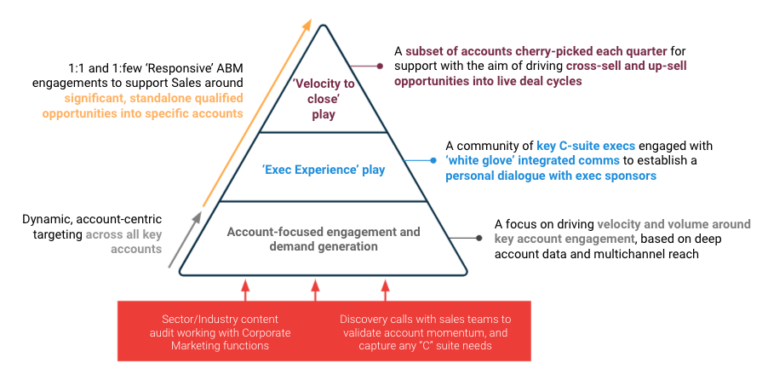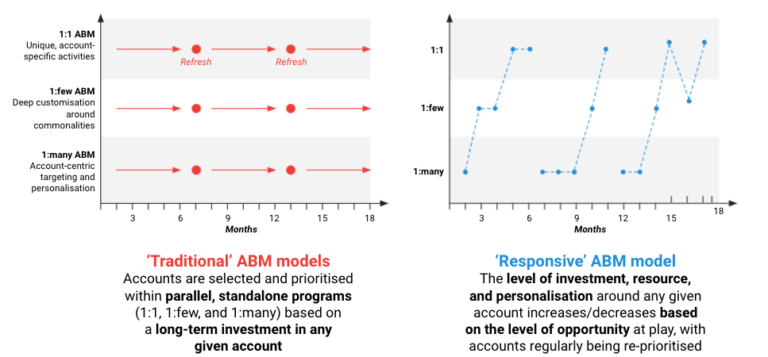At Agent3, we are committed to ‘true’ ABM, ie, accelerating growth with an organization’s most important customers and prospects, helping our clients to strike while the iron’s hot, marketing to high-value accounts as if they’re individual markets. Using a combination of data, technology and content, we help clients identify those ‘ripe’ accounts, and then engage with them to deliver real commercial value, quickly.
So far, so good. But deciding which accounts should be treated on a 1:1 or 1:few basis isn’t always straightforward and, indeed, presents one of the biggest challenges to ABM program planning. Do you put all your eggs in a relatively small basket by honing in on just a few accounts? Or do you hedge your bets and spread your investment, but risk tapering your level of potential pay-off?
Wouldn’t it be great if you didn’t have to choose one approach or the other?
At Agent3, we don’t think you necessarily have to. Introducing Responsive ABM…
What is Responsive ABM?
Responsive ABM is built on the foundations of ‘traditional’ 1:1 and 1:few ABM, but takes a more dynamic approach to account selection, enabling accounts to move into and out of 1:1 activity for fluid periods of time, in order to support the accounts showing the highest propensity, or those with the biggest upcoming opportunities.

A broad group of high-priority accounts are served with a layer of ‘Always-On’ support, in the form of digital activation and semi-automated sales enablement to ensure that all accounts receive a level of account-relevant messaging, and all sales teams receive a level of heightened support. This may be industry-personalized and pain point focused to go a step beyond the Product and Solutions Marketing campaigns they might otherwise be included in.
Accounts then ‘move up’ the triangle to receive additional support based on sales intelligence and intent signals. Sales may nominate accounts for ‘Exec Engagement’ or ‘Velocity to Close’ support where they have big upcoming opportunities such as a meeting with an executive or an RfP. In effect: your level of resource investment into any given account increases as they show their hand as being likely to engage.

The Responsive model doesn’t have to replace, but can run in parallel to, ‘traditional’ ABM programs, particularly for organizations who are further along the ITSMA’s ABM Adoption Model. These organizations have well established 1:1, 1:Few and 1:Many programs, offering long term investment to given accounts and sales teams. Responsive ABM may be layered on top, to provide additional support to those accounts that did not meet the criteria to be part of a 1:1 program, but have significant upcoming opportunities where additional marketing support could really help to move the needle – such as the role change of a senior target title, or account level changes like mergers or acquisitions .
Responsive ABM offers the ability to scale 1:1 outreach by offering ‘moment in time’ support to the accounts with the biggest upcoming opportunities. Sales teams are provided with additional marketing resource and budget around significant, standalone qualified opportunities into specific accounts. There is less of a long term commitment than we typically see with 1:1 ABM, which allows more accounts and sales teams to be supported over a given period of time.
According to the ITSMA, 48% of ABM’ers plan to adopt a blended ABM approach in 2021 to cover more accounts, clusters or segments.
Data
It’s important not to forget about the role that data has to play in identifying the biggest upcoming opportunities as well.
In order to qualify accounts for additional marketing support in the Exec Engagement and Velocity-to-Close level, it’s key to pull in as many data sources as possible to gain a holistic view of an account’s engagement with your organization. Everything from pure Intent data, through to web analytics and digital campaign engagement.
According to the ITSMA, 58% of the most effective ABM campaigns already leverage Intent data. But which other data sources should be leveraged?
It can be really challenging to read all of those different data sources, and derive something meaningful from it, so we’ve been working on a solution to help our clients synthesise these disparate insights and take clear, tangible actions as a result.
Our newly developed Intent Prioritization Dashboard pools all of the data sources listed above, as well as many others, in order to give you a holistic – yet simplified – view of an account’s engagement.
Not only does the dashboard pool all data sources to provide you with a single source of truth, we’ve also worked to weight the value of this data so that more recent and more valuable interactions drive a higher score. For example, an account visiting your website shows a higher level of interest than an account searching for a similar keyword elsewhere on the web. And an account visiting your website this week shows higher interest than someone who visited this month. You can start to see how the value and quality of different data points quickly emerges.
This not only allows sales to prioritize their accounts for outreach, but it allows marketers to identify the accounts showing the highest interest at a given time. By reserving ABM budget for these opportunities, we’re able to support accounts at a moment in time where the greatest impact may be driven.
The Responsive model allows for a very scalable approach to 1:1 engagement, with more accounts being served and supported on a 1:1 basis over time. We’re seeing huge success with this approach, particularly for clients who are embarking on their ABM journey for the first time. It’s an easy way to get up and running with Account-Based Marketing, while reserving resource and budget for the biggest upcoming opportunities, and ultimately influencing more sales teams and more deals over time.
So, by combining data, creativity and technology we think we may just have helped turn one of ABM’s biggest challenges – account selection and prioritization – into one of its biggest opportunities!
If you want to find out more, we’d love to hear from you!
